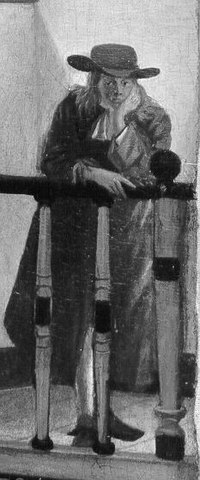Willem Godschalck van Focquenbroch
Willem Godschalck van Focquenbroch (* probably in April 1630 in Amsterdam ; † possibly 14 July 1670 in Elmina ) was a Dutch poet and playwright . He is considered to be the most important representative of the burlesque of the 17th century in his mother country. He is colloquially called de Focq by his compatriots, with whom he is still popular today , as Focquenbroch did in his own letters.
Life
Focquenbroch was baptized on April 26, 1640 in the Oude Kerk in Amsterdam, his exact date of birth is unknown. His parents were the then 42-year-old Pouwels (Paulus) van Focquenbroch and his wife Catrina Sweers, who was 10 years his junior. The father seems to have been a successful merchant and trader by turns. In 1644 he bought De Zilveren Doornenkroon on Amsterdam's Anthonisbreestraat for 9,800 guilders. He probably got into financial problems later because he sold the house again a little later for 10,750 guilders. The mother Catrina Sweers came from a carpenter family in Antwerp. Their first two children, Hanneke and Paulus junior, both died within the first two years of their lives. Four more children were born after Willem, brother Jacobus and three girls.
The brothers probably attended the Latin school of Jacobus Heyblock , who was part of the family. In any case, Focquenbroch wrote a poem about Heyblock: Aen Mijn Heer Jacob Heyblock . Later Focquenbroch studied medicine at the Athenaeum Illustre Amsterdam , but could not do his doctorate in Amsterdam, so that he enrolled at the University of Utrecht on March 29, 1662 , where he received his doctorate on venereal diseases less four months later with his work De lue venerea .
Little is known about his life at that time and his circle of friends. He probably dedicated some of his poems from that time to friends from his studies such as Johannes van Bersingen , Johannes van Royen or Aernout van Overbeke . It is certain that Johannes Ulaeus was one of his best friends and that he was on friendly terms with Johannes van den Bergh . He dedicated various poems to Maria van Sypesteyn , with whom he may have had a love affair. He was also in correspondence with Constantijn Huygens , with whom he probably had no further relationship.
It is known that from 1668, two years after the death of his father, Focquenbroch earned his own income as a doctor, which was not enough for a satisfactory lifestyle. In order to earn better, Focqenbroch applied to the WIC ( West Indian Compagnie ) in the same year and was sent to the Gold Coast of Ghana as a kind of customs officer , where he worked in the Portuguese fort São Jorge da Mina near Elmina , which the Dutch followed in 1637 many unsuccessful previous attempts had conquered his job and received much higher salaries than previously. Its main task was to arrest lorredraaiers , ships that traded without official permission, and to condemn the keepers. He was also responsible for maintaining general order among the WIC staff in the fort. Focquenbroch now liked to call himself “de tweede persoon van een klein koninkrijk” (deputy ruler of a small kingdom), as he was ranked directly behind the governor.
Johannes Ulaeus received various letters from Focquenbroch in Elmina. The first letter still had a cheerful tone, but that quickly changed. In his second letter he wrote:
“... in dit barbaarsche, melancholique, en verbaesde dorre land, 't welck ik niet gezind ben heel net af te schilderen, uyt vrees dat gij schreyen soud as a child, en de arme focq complain, om dat hem het noodlot in soo verdoemde plek brought heeft. "
“De Focq” felt very lonely, and when his nephew Philip van Heeden who was traveling with him dies, he feels at the end. He probably succumbed to one of the many epidemics that hit the occupiers in Elmina shortly afterwards. The exact date of his death is not known, but it must be between 1670 and 1673. There are vague indications in WIC papers that the date was July 14th, 1670, but the official document confirming this has been lost. However, it is known that after 1670 the function of fiscal officer in Elmina was vacant.
Works
- De verwarde jalousy, Blyspel . Amsterdam: Jacob Lescaille, 1663.
- Klucht van de weyery . Amsterdam: Jacob Vinckel, 1665.
- Klucht van Hans Keyenvresser . Amsterdam: Jacob Vinckel, 1665.
- Thalia, of geurige sanggoddin . Amsterdam: Johannes van den Bergh, 1665.
- Een Hollandsche vuystslagh, op een Brabandsche koon . Z.pl. [1665].
- Doubled zegensangh, the negen muse . Amsterdam: Johannes van den Bergh, 1666.
- De herderssangen van Virgilius Maro . Amsterdam: Johannes van den Bergh, 1666.
- Thalia, of geurige zanggoddin, tweede deel . Amsterdam: Johannes van den Bergh, 1668/1669.
- Min in't lazarushuys, Blyspel . Amsterdam: Jacob Vinckel, 1674.
- Afrikaense Thalia, of het derde deel van de geurige zanggodin . Amsterdam: Jan ten Hoorn, 1678.
literature
- P. Kroone: Willem Godschalck van Focquenbroch, z'n family, z'n vrienden en z'n work . Diploma thesis 1982
- WG van Focquenbroch: Afrikaanse brieven van Willem Godschalk van Focquenbroch. Prometheus BV Vassallucci 2007. ISBN 90-446-0887-8 (Dutch)
Web links
- Jan Helwig: Foreword to the 1986 Afrikaense Thalia edition ( PDF file; 129 kB)
- Website of the Facquenbroch Foundation (Dutch)
- Collegenet: detailed biography and bibliography with many content examples (Dutch)
| personal data | |
|---|---|
| SURNAME | Focquenbroch, Willem Godschalck van |
| BRIEF DESCRIPTION | Dutch poet and playwright |
| DATE OF BIRTH | around April 1630 |
| PLACE OF BIRTH | Amsterdam |
| DATE OF DEATH | around July 14, 1670 |
| Place of death | Elmina |

